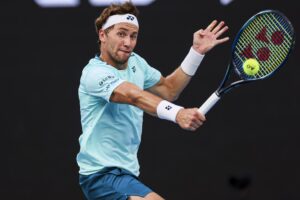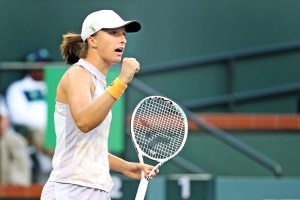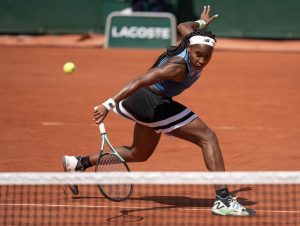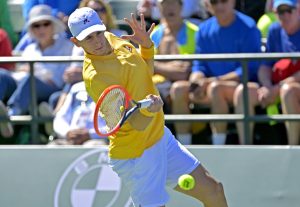The last time we saw Novak Djokovic out on the court, he was falling in the Bronze Medal match against Pablo Carreno Busta. It was a physical three-set match, 4-6, 7-6(6), 3-6, exactly the type of match that Djokovic usually wins.
It was the second-straight defeat for a weary-looking Djokovic, who had lost to Alexander Zverev 6-1 3-6 1-6 in his previous match.
Olympic Losses for Novak Djokovic
The matches with Zverev and Carreno Busta could not have been more different in terms of the area of Djokovic’s game letting him down, however. Against Zverev, it was the serve that faltered. Djokovic only won 56% of his first-serve points and 37% of his second-serve points against the German. In the third set, Djokovic won 18% of the points on his second serve.
Against Carreno Busta, Djokovic failed to break serve once, and missed out on all eight break points he generated during the match. In fact, dating back to the third set of the Zverev match, the Serb failed to break on 12 consecutive break points. For a player as clutch as Djokovic, that’s almost unheard of.
During the Carreno Busta match, Djokovic showed massive frustrations. He threw his racquet into the empty stands and broke a racquet during the defeat. His game dissolved in the oppressive Tokyo heat.
Following his Olympics singles defeats, Djokovic pulled out of the mixed doubles Bronze Medal match. He had picked up an left shoulder injury and was unable to compete.
But, that wouldn’t be the last withdrawal for Djokovic during the summer hard-court swing. He also pulled out of Toronto and Cincinnati.
Regarding his withdrawal from Cincinnati, Djokovic told his fanbase the following: “Dear Nole Fam, I wanted to share with you that I’m taking a bit longer to recover after quite a physically taxing journey from Australian Open up to Tokyo…”
Djokovic’s Health Approaching US Open
Now, there can certainly be a lot of conjecture regarding the vague nature of Djokovic’s statement, and the only ones who really know his physical state are in his camp. But, it’s certainly not good that Djokovic is not competing in any North American warmup to the US Open before taking the court in Flushing Meadows.
Djokovic will also be under extraordinary pressure at the US Open. Having won the Australian Open, French Open, and Wimbledon, Djokovic is both vying for the calendar year Grand Slam and to pass Roger Federer and Rafael Nadal’s 20 career singles Slam titles.
We saw what happened to Serena Williams at the US Open in 2015. In the semifinals, with an almost-suffocating energy buzzing around Arthur Ashe Stadium, Williams cracked and fell in a tight three-setter to unseeded Roberta Vinci. Her quest for the calendar-year Grand Slam came to a crashing halt.
But, if Novak Djokovic were to lose, will it be a Vinci-type of player who pulls the shocker?
Threats in the field
Well, there are two players who are in great form and could be a nightmare for Djokovic in New York.
The first is one of his conquerers in Tokyo: World No. 5 Alexander Zverev. Zverev went on to win the Gold Medal. He and then came for Cincinnati, where he won that title as well. During the Olympics, no opponent won over 55% of their second serve points against Zverev and only one opponent (Nicoloz Basilashvili) won over 70% of their first-serve points. Zverev also never had a match during that tournament where he put less than 64% of his first serves in play.
Following the Olympic Gold Medal, tennis.com’s Ed McGrogan reported Zverev saying, “This is the biggest tournament you can win, in any sport.” Zverev will need to keep up that mentality of playing his best on the biggest stages as the US Open approaches.
In Cincinnati, Zverev won at least 85% of the points on his first serve in every match but the Tsitsipas semifinal, and served a combined 46 aces compared to 13 double faults. In the final, Zverev won 93% of his first-serve points. With service numbers like this, Djokovic would absolutely have his hands full if he had to take on Zverev at the US Open.
Another potential roadblock for the Serb is World No. 2, Daniil Medvedev. Medvedev was victorious at the ATP Masters 1000 event in Toronto last week. Medvedev won over 80% of his first-serve points in four of his five matches in Toronto, the only exception being when he “only” won 79% of his first serves in the quarterfinals against Hubert Hurkacz.
Hurkacz was also the only player to win over 50% of their second serve points against Medvedev last week, with the Russian holding big servers John Isner and Reilly Opelka to 17% and 38% second serves won, respectively. Medvedev was broken four times all tournament.
Last week in Cincinnati, Medvedev made the semifinals. None of his four opponents in the Queen City won over 32% of their second serves. Before his loss to Andrey Rublev in the final four, Medvedev had won over 90% of his first serves in two of his first three matches. It’s clear that Medvedev is yet another huge threat to Djokovic at the upcoming US Open.
And, yes, it is true that Djokovic comfortably beat Medvedev in the Australian Open final. And yes, he was dealing with a right ab injury from the Fritz match onwards during that tournament, so he’s no stranger to play high-stakes matches not at 100%. But, he didn’t have 43 matches of wear-and-tear on his body yet during that time, which is certainly not easy on someone in their mid-30s.
However, it is important to note that Medvedev injured his hand on an on-court camera, so that’s something to keep an eye on as he prepares for the US Open. The injury didn’t look too severe, however, and it shouldn’t be a lingering concern.
Daniil Medvedev vs Novak Djokovic
How would these two players match up with Djokovic in a US Open final (or semifinal for Zverev)? Well, for Medvedev, in that Australian Open final, his second serve was eaten alive. He only won 9/28 points on his second serve and was broken seven times in the three-set match. It almost seemed like it would have been more beneficial for Medvedev to go for more on his second serve and risk double faulting more (he hit four in the match) to try to boost that second serve win percentage.
Something else that was interesting about that match was how Djokovic won 16/18 of his net points. For someone with as much precision from the baseline as Medvedev, including his passing shots, and given that Djokovic’s volleys are good-but-not-great, it’s shocking that he struggled this much with Djokovic at the net. Medvedev would do well to look back at tape of that match and figure out his patterns with Djokovic at the net in order to vary them for this match. It could have just been the pressure of the match led to less precision, and perhaps this would improve with another Major final under his belt.
Medvedev also hit 30 errors compared to 24 winners in the match. For someone who models his game on consistent depth like the Russian, that’s not good enough against a player of Djokovic’s caliber. Again, it could be due to nerves, but Medvedev really needs to make sure he’s not gifting points to Djokovic. He needs depth against the Djokovic backhand especially, as that’s the Serb’s better wing.
Alexander Zverev vs Novak Djokovic
For Zverev, something he did really well against Djokovic at the Olympics was attacking his second serve. He won 63% of the points on Djokovic’s second serve for a reason. He will need to keep up this aggressive mindset in a rematch at the US Open.
In addition, a problem that Zverev has (besides the occasional lapse in his serve which leads to plenty of double faults) is that he is sometimes too content to sit well-behind the baseline and try to grind through points. For an elite baseline player like Djokovic, this makes his life so much easier, as he can dictate play from the baseline and not have to worry as much about defending against Zverev’s massive backhand.
Zverev is 6 foot, 6 inches (198 centimeters) tall. He is a huge physical presence on the court with a huge game. He needs to show this in his tennis with an aggressive style of play, hitting with enough consistent depth with the forehand that he’s able to stay neutral in rallies and then take control with the backhand.
So, with all of this said, should Novak Djokovic be the favorite for this year’s US Open?
Is Novak Djokovic the Favorite or No?
Let’s be honest here: It would be silly for Djokovic not to be. Let’s remember that he’s largely dominated throughout this year’s Majors and has won the US Open title three times, more than the rest of the draw combined. Djokovic is also one of most mentally tough athletes in the world, punctuated by his 2019 Wimbledon victory over Roger Federer in the final, saving two match points in the process.
And Zverev and Medvedev aren’t exactly the most mentally tough players either. Look at Zverev in the 2020 US Open final losing from two-sets-and-a-break up. Or Medvedev in Cincinnati, rel=”noopener” target=”_blank”kicking the (improperly placed) camera and completely losing focus and control over the match. When the going gets tough, Djokovic is certainly the more likely player to handle it well.
But, is Djokovic a shoo-in to win the title, the way it felt during his Wimbledon run? Not by a long shot.
With Medvedev and Zverev ramping up in form and starting to peak for the year’s final Major, along with other dangerous players such as Stefanos Tsitsipas and Pablo Carreno Busta in the mix, Djokovic will need to be 100% healthy to navigate this tricky draw.
And with the pressure of winning a fourth Major this year growing with every match, there’s always the chance that Djokovic gets in his own head, especially in a tight match, and implodes.
So, while Novak Djokovic is certainly the favorite, the US Open is shaping up to be the most wide open men’s Grand Slam of the season.
Main Photo from Getty.






